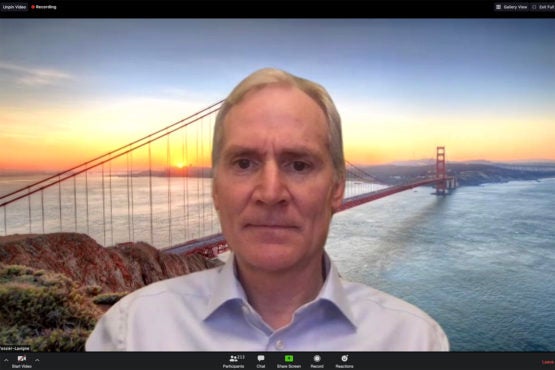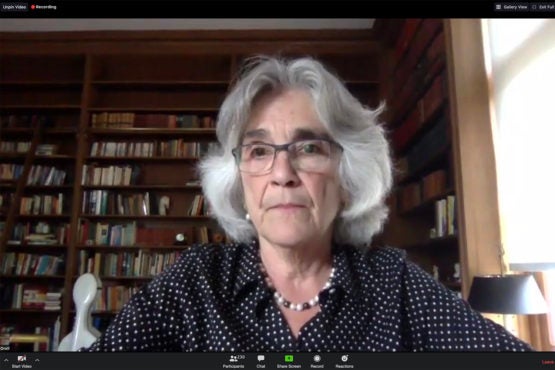Faculty Senate discusses Stanford’s ongoing response to COVID-19 crisis
At the April 16 Faculty Senate meeting, Provost Persis Drell discussed the impact of the pandemic on the current budget and plans to resume the budget process for 2021. President Marc Tessier-Lavigne announced a new website that aggregates Stanford research efforts and gave a brief report on planning for the aftermath of the crisis.

President Marc Tessier-Lavigne talked about Stanford’s research efforts to tackle the COVID-19 crisis at the virtual meeting of the Faculty Senate on Thursday. (Image credit: Andrew Brodhead)
The Faculty Senate chose an open forum for its Thursday meeting that allowed senators to engage in an extended Q&A with university leaders, including President Marc Tessier-Lavigne and Provost Persis Drell.
In addition, senators were able to pose direct questions to leaders in Stanford Medicine, Student Affairs, Research and Graduate Education, as well as staff members charged with planning recovery activities for the aftermath of the crisis, including staging a return to the university’s research laboratories.
It was the second senate meeting held via Zoom in order to comply with the California shelter-in-place order, which was issued in mid-March.
Both Tessier-Lavigne and Drell gave short presentations before the forum was opened up for the senators’ virtual questions.
President’s remarks
Tessier-Lavigne said that Stanford will be guided by three overarching principles as the university continues to respond to the uncertainty caused by the pandemic: supporting students; contributing to the fight against COVID-19; and positioning Stanford for recovery.
He said Stanford’s researchers “have thrown themselves on COVID-19,” launching projects on preventing, diagnosing and treating the disease, and deciphering how it spreads. Other researchers are studying how the pandemic is affecting society.
Tessier-Lavigne called attention to a new research website, Stanford RISE, which stands for Respond, Innovate, Scale, Empower. The website was created to house the wide variety of COVID-19 research being done on campus.
He said the 200 research projects already featured on the website have been organized into four broad thematic areas: rapid discovery, human resilience, inclusive recovery and post-pandemic cooperation. The website will be updated as Stanford RISE receives additional information on projects.
“The aim, again, is to facilitate collaboration among researchers, by making all of these projects available across our community,” said Tessier-Lavigne, who encouraged everyone to visit the RISE website.
While the university tackles immediate issues, Tessier-Lavigne said it is also important to begin thinking about how to manage the aftermath of the crisis and get the campus back to a “new normal.” He said one of the issues the research policy and implementation group is tackling is how to stage a return to the university’s research labs. Another group is focused on education. And a third group is focused on defining options for fall quarter, taking into account the best thinking available about the trajectory of the disease.
Provost’s report
In her presentation, Drell, the university’s chief budget and academic officer, offered a first look at the current fiscal year, saying Stanford has seen a roughly $200 million reversal in the consolidated budget of the university.

At the meeting, Provost Persis Drell discussed the impact the crisis is having on Stanford’s financial picture. (Image credit: Andrew Brodhead)
“To put that in context, if you remember my presentation to you last year, we anticipated that we would end fiscal year 2020 with a projected $126 million surplus, mostly in restricted use and legally restricted and designated fund balances – funds whose use is restricted by law or designated by policy,” she said. “The $200 million swing negative is distributed across many different fund types and we believe that at least $100 million of that will hit general funds, our most precious, unrestricted source of funds that supports many, many things at Stanford, including staff, faculty and student financial aid.
As a result of the pandemic, Stanford has seen a decrease in revenue, increases in financial costs and new expenditures related to the pandemic.
“The primary source of funds to cover this shortfall will be the reserves that were built over the decade since the 2009 downturn,” she said. “However, these resources will be significantly diminished to close out this fiscal year.”
Drell reiterated the “unprecedented uncertainties” facing Stanford as a result of the COVID-19 crisis.
Among those uncertainties: No one knows yet what the “new normal” will look like once the shelter-in-place order is lifted. No one knows yet how the disease will impact the economy and Stanford’s endowment, which is a primary source of the resources that support the university – except that impact on the endowment payout is expected to be significant.
“And then there is real uncertainty in when we will be able to be a residential undergraduate institution again,” Drell said. “We, along with all of our peers, are struggling to determine what fall will look like.”
Drell said the university put the 2021 budget process on hold as the crisis developed, but will need to resume the process within the next three months.
“At this point, all we can do is look at budget scenarios for the coming year, because we simply do not have the information we need to make any decisions,” she said. “My goal is that with some scenario planning we will be in the best position possible to make thoughtful decisions, sometime in June, about budgets for the next fiscal year.”
She noted that the pandemic may dramatically affect the population of graduate students, because many international students are outside the country and may not be able to obtain visas to come to the United States.
Drell said the university leadership will meet with the Stanford University Board of Trustees in April and June before making decisions on the financial path forward. She said Stanford will need to know a great deal more about the state of the economy before the university can choose a path.
“Any strategy we choose will have advantages and disadvantages that must be taken into consideration,” she said. “In all scenarios, I do anticipate that we will have to make some very difficult decisions.”
Drell said a frequent question in last week’s town hall meeting was if and when there will be staff layoffs. She reiterated that the university doesn’t know the answers to those questions yet.
Open forum
In the open forum section of the meeting, senators raised a variety of issues for discussion, including the effects of the coronavirus pandemic on employees, decision making about the fall quarter, steps to re-starting research and issues facing undergraduate and graduate students.
In answering several questions about pay continuation, Drell cited the new initiatives outlined in an April 14 letter to the Stanford community:
- Continue paying all regular Stanford employees (both full-time and part-time benefits-eligible employees) through June 15, the end of spring quarter. This includes Stanford employees who are represented by a union. Stanford will continue to provide regular pay for these employees, even if the need for their services is reduced due to the pandemic.
- Create a new grant program to support Stanford employees who are facing financial hardships – including those who work in certain contingent roles that are not eligible for pay continuation.
- Work with the contract firms whose employees provide ongoing meal, child care, cleaning and sanitation, security and transit services at Stanford so that, with Stanford resources and the resources offered by the government, these firms will be supported in maintaining income and benefits for these employees through June 15.
- Reach out to assist vendors who rent space on campus to operate their businesses.
In answer to a question by Erica Scott, president of the Associated Students of Stanford University, Drell said she was willing to meet with ASSU student leaders about initiatives related to contract workers.
Responding to a question about the considerations that will be weighed about fall quarter, Drell said the “first and foremost” consideration will be the health and safety of students.
“And, of course, that’s a little challenging because there is so much about the disease and the spread of the disease that we just don’t know,” she said.
Drell said Stanford’s late start date for the fall quarter is a huge advantage, because Stanford starts about month later than most of its peers.
“We’re going to have the benefit of seeing what some of the solutions and options are before we need to commit,” she said. “We were an early mover in shutting down and going online. We can be a late mover because of the date when we start in the fall. We’re going to take full advantage of that.”
In another question, a senator asked if Stanford would consider changing the structure of the upcoming academic year to winter, spring and summer quarters, as some other universities are reported to be considering. Drell responded that yes, it was being contemplated among other options.
There were also questions about how Stanford could help PhD students who will be graduating in June – a time when many universities will not be hiring.
Another senator expressed concern that students with mental health problems will not be receiving the care they need, now that they are dispersed across the country. Vice Provost for Student Affairs Susie Brubaker-Cole said Counseling and Psychological Services (CAPS) is working to support students’ needs in a number of ways and encouraged students to be in touch with the office for support, wherever they are this quarter.
The presentations and discussion will be published in the minutes of the meeting. The next senate meeting will be held on Thursday, April 23.
